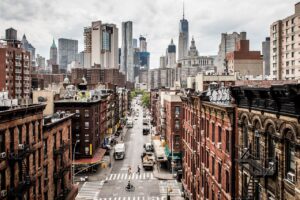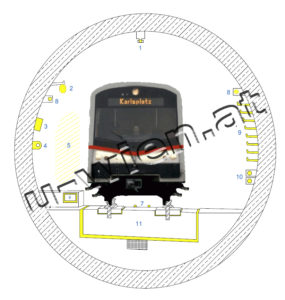Energy is not wasted at Wiener Linien. Electricity has already been generated when braking subway and streetcar trains – but this could only be used by other trains in the immediate vicinity. Now, the electricity produced during braking is also to supply subway stations.
Brake Energy
When braking, subway trains and modern streetcars supply electricity that is used by other vehicles, for example, to start up. If there is no vehicle nearby, the unused electricity is converted into heat. The electricity could be put to good use in the subway station.
What’s behind it
Whether it’s the Bim or the subway – almost all rail vehicles operated by Wiener Linien are already small “power plants: The energy that is released during braking flows back into the DC network and can thus power other vehicles in the vicinity with this released energy when starting up. But what can be done when no train needs this energy at the same time? Originally, this energy remained unused and was converted into heat. However, in order to make the best possible use of it, Wiener Linien sought an innovative solution and launched the “Brake Energy” project.
Since 2005, Wiener Linien has been operating its own growing 20 kV AC network for station supply along the subway, into which new stations are constantly being integrated. This network is receptive and runs stably and was therefore ideally suited for the pilot plant for energy recovery. However, in order to be able to use the direct current fed into the medium-voltage grid, it was necessary to install an inverter system. This can convert the direct current into alternating current. The priority in the metro network remains the exchange of energy between the braking and the starting trains. If this energy flow is not possible, the released direct current is converted into alternating current and fed into the Wiener Linien 20-kV grid. In this way, it is available to supply the equipment in the stations, such as lighting, elevators, escalators, ventilation, etc.
The “Brake Energy” project was launched in September 2014. A network analysis proved the U2 station Hardeggasse to be the optimal location. The substation was installed in September 2016 and has been in continuous operation since February 2017. An energy feed-in of 1.6 GWh per year (roughly equivalent to the annual energy consumption of 360 average households) reduces energy costs by up to 100,000 euros per plant.
The problem
Subway and streetcar trains are supplied with direct current, but the station network requires alternating current.
The solution
With an inverter system, the braking energy can be fed into the AC network. This makes it possible, for example, to supply the lighting, escalators or elevators in a subway station with electricity.
Summary
Brake Energy: From the drive, which is also a generator, excess direct current is first fed into the grid, then converted to alternating current by an inverter system, and finally fed into the subway station grid.
Brake: The braking resistor converts unused energy from the drive/generator into heat.



